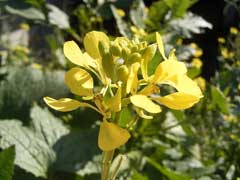
Charlock, Charlock mustard, Wild mustard
Latin Name: Sinapis arvensis
USDA Hardiness: 5-9
Native Range: TEMPERATE ASIA: United Arab Emirates, Kuwait, Oman, Qatar, Saudi Arabia, Afghanistan, Iran, Iraq, Israel, Jordan, Lebanon, Syria, Russian Federation-Ciscaucasia (Ciscaucasia), Armenia, Azerbaijan, Georgia, Russian Federation-Western Siberia (Western Siberia (south)), Russian Federation-Eastern Siberia (Eastern Siberia (south)), Kazakhstan, Kyrgyzstan, Tajikistan, Turkmenistan, Uzbekistan, China (Xinjiang Uygur Zizhiqu) TROPICAL ASIA: Pakistan (north) EUROPE: Denmark, Finland (south), United Kingdom, Ireland, Norway, Sweden (south), Austria, Belgium, Switzerland, Czech Republic, Germany, Hungary, Netherlands, Poland, Slovakia, Russian Federation (European part), Belarus, Estonia, Lithuania, Latvia, Moldova, Ukraine (incl. Krym), Albania, Bulgaria, Bosnia and Herzegovina, Greece (incl. Crete), Croatia, Italy (incl. Sardinia, Sicily), North Macedonia, Montenegro, Romania, Serbia, Slovenia, Spain (incl. Baleares), France (incl. Corsica), Portugal AFRICA: Algeria (north), Egypt, Libya, Morocco, Tunisia
Edibility Rating: 2 / 5
Medicinal Rating: 1 / 5
Region:
Family:
Plant Type:
Medicinal Uses
Edible Uses
Edible Parts: Flowers Leaves Oil Oil Seed Shoots | Edible Uses: Condiment Oil OilLeaves - raw or cooked[2, 4, 5, 12, 74]. Somewhat hot, the young leaves are used as a flavouring in salads, where they add a piquant flavour[9, 183]. Older leaves are used as a potherb[183]. It is best to use just the young shoots and leaves in the spring, older leaves are bitter[9]. Flowering stems - cooked[9, 74]. A pleasant, cabbage/radish flavour, they can be used as a broccoli substitute before the flowers open[183]. The stems should be lightly steamed for no more than 5 minutes[9]. The flowers can also be cooked as a vegetable or used as a garnish[183]. Seed - it can be sprouted and eaten raw[12]. A hot flavour, it can be added to salads and sandwiches[183]. The seed can be ground into a powder and used as a food flavouring. It has a hot mustard flavour[4, 9, 46, 115]. An edible oil is obtained from the seed[1, 57, 74].
Cultivation
Usually found on heavy alkaline soils in the wild[17]. Succeeds on most soils. Dislikes shade. The plant harbours an eelworm that attacks other crops[13]. It is therefore best not to grow it in a garden setting.
Known Hazards
The plant is possibly poisonous once the seedpods have formed[76].
Habitats
Cultivated ground, usually on heavy calcareous soils[13, 17]. A serious weed of agriculture, especially in spring sown crops[1, 17].